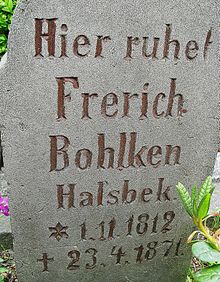Westerstede-Felde Baptist Cemetery
The Baptist Friedhof Westerstede-Felde (also called Baptistischer Friedhof Felde ) is the oldest burial place of the German Baptists . It is located at Wittenheimstrasse 22 in the Westersted district of Felde . On the same property there is a Baptist prayer house , which today - apart from concerts and special services - is used as a cemetery chapel. The parish life of the Evangelical Free Church Community, which owns the Felder cemetery, shifted to the center of Westersted in the second half of the 20th century.
history
In the 19th century most of the cemeteries were owned by the state churches . Baptists and other dissidents were usually not allowed to have their deceased buried by clergy of their faith community. Frerich Bohlken , the first elder of the congregation of baptized Christians founded in 1849, started a cemetery around 1850, initially without permission from the authorities, on the property of the Felder prayer house. He subsequently informed the responsible authorities that the first funeral had taken place there and interpreted the lack of an answer as a toleration. In 1851 a child of the Gerdes haymaker family from Eggelohe died . The bailiff von Berg learned of the intended burial in the Baptist cemetery and imposed a ban on the threat of a fine of five Reichstalers . Bohlken turned to the Oldenburg government . After seventeen days he received from there the provisional approval for the burial of the child. It was not until October 16, 1851 that the Felde Baptist congregation was officially allowed to use its property as a cemetery. Johann Gerhard Oncken , who was on a mission trip to Felde at the end of July 1852, reported to the American Baptist Foreign Mission Society in September of the same year that he had found “two small graves” in the Felder Baptist cemetery.
One of the conditions associated with the official permit was the listing of all those interested in the cemetery. In 1854 the municipality complied with this request and named 94 names in a directory. The places of residence of those interested were Apen , Burgforde , Eggeloge, Eggelogerfeld, Felde, Fikensolt , Halsbek , Hoheliet, Hollwege , Jührdenerfeld, Langebrugge, Mansie , Moorburg , Neuchâtel , New England , Seggern , Torsholt , Westerstede, Westerloy and Westerstederfeld.
Originally, according to the cemetery regulations, only uniform wooden crosses were allowed as grave monuments. Later this was replaced by also uniform small tombstones. In the years after the Second World War , this tradition was broken, as refugees and displaced persons who had moved in, as well as community members from other regions of Germany, rejected the simplicity of a uniform grave design.
The cemetery is still in use today.
literature
- Gisela Heise: 1849 - time leaps - 1999. Episodes from 150 years of community history. Becoming and growing the Baptist church Westerstede. Westerstede 1999.
Individual evidence
- ^ Joseph Lehmann: History of the German Baptists , Volume II (revised by Friedrich Wilhelm Herrmann), Cassel 1922, p. 39.
- ↑ After the amalgamation of Baptists and Brethren Churches in 1942, German Baptists referred to themselves as Evangelical Free Churches - often with the addition of "Baptists" in brackets.
- ↑ a b Article on the Felde Baptist Cemetery on the pages of the Evangelical Free Church Community Westerstede ( Memento from September 29, 2007 in the Internet Archive ); Accessed May 19, 2009
- ↑ "two little graves"; American Baptist Foreign Mission Society (Ed.): The Missionary Magazine , Volume 33, March 1853, p. 11 (Column II); ( online )
- ↑ At that time, the Baptist church had 90 members.
- ↑ see photo gravestone Friedrich Bohlken !
Web links
- Article on the Felde Baptist Cemetery on the website of the Evangelical Free Church Community Westerstede ( Memento from September 29, 2007 in the Internet Archive ); Accessed May 19, 2009.
- Site of a Westerstede funeral home: cemeteries in and around Westerstede ; Accessed May 19, 2009.
Coordinates: 53 ° 16 ′ 57.9 " N , 7 ° 55 ′ 29.3" E


